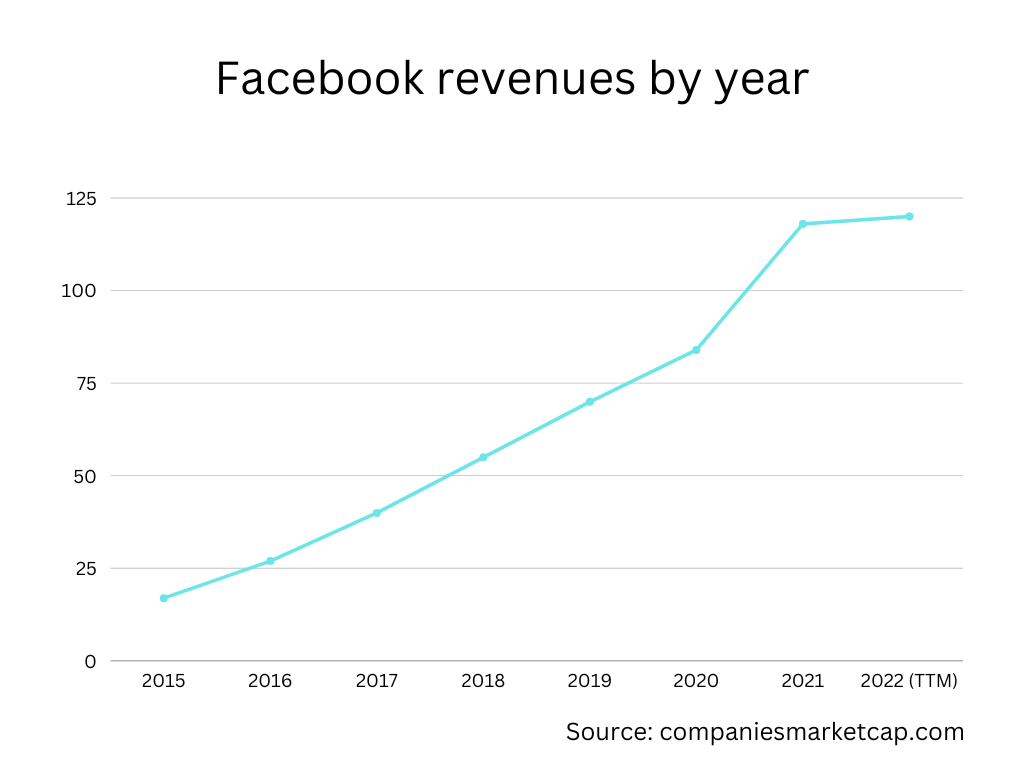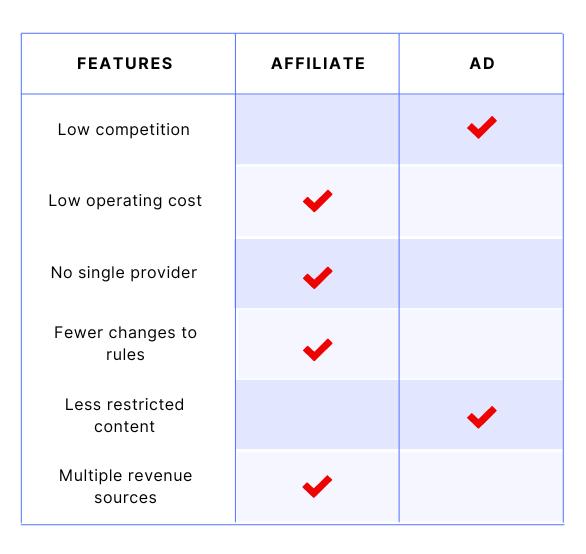Ad vs. affiliate websites: these are two common income sources for content websites. Each of them has its own benefits and drawbacks, but they can both be good investments. Some investors have success with ad websites, while others do well with affiliate sites. Nevertheless, for the majority of investors, affiliate sites are the better choice, whether buying or building. Why? In this article I look at the differences and why affiliate sites tend to be the best option.
Table of Contents
- What are ad supported sites?
- What are affiliate sites?
- Differences between ad vs. affiliate websites
- Benefits of ad supported sites
- Drawbacks of ad supported sites
- Benefits of affiliate sites
- Drawbacks of affiliate sites
- How to get started investing in websites
- Key points
What are ad supported sites?
The majority of the largest content sites on the Internet are (mostly) ad supported. This means that they sell ad space in order to earn an income.
Advertisers place ads on sites based on the site’s traffic as well as the demographics of the site’s users. On certain sites, with lots of wealthy users who are looking to purchase something, advertisers will pay a premium for ad placement. On other sites, advertisers pay less.
Very large sites are able to negotiate directly with advertisers to get the highest rates. Other sites need to work with an intermediary who brings its own inventory of advertisers for a cut of the income. The most common intermediary is Google, but there are multiple intermediaries and there can be more than one level of intermediary.
Most ads that appear on content sites are targeted to users based on their browsing history. That is, if you have looked at a leather jacket on one site, you will likely see targeted ads for leather jackets on other sites. Advertisers pay the most for these ads because they show intent to purchase.
What are affiliate sites?
Affiliate sites make money by recommending products and earning a commission for each product sold. For instance, a fishing affiliate site may recommend a certain fishing rod. The site links to an online store, where readers can buy that fishing rod. When a purchase is made, the affiliate site earns part of the sale price.
The amount of money that stores pay out depends on the price of the product, and is usually a certain percentage. The percentage varies widely by niche — some information products pay 50% or more in commission, while competitive products like electronics pay 2% or less. Still, if the purchase is large, this can add up to hundreds — or even thousands — of dollars.
Given the number of online stores around, and the number of different products that can be recommended, there are millions of affiliate sites on the Internet. They span the range of nearly every possible product.
In the past, these sites got traffic by listing the best products in a certain niche. These days, sites need to be more strategic in how they attract potential buyers.
Differences between ad vs. affiliate websites
| Affiliate | Ad supported | |
|---|---|---|
| Amount earned per user | Generally $1-$100+ | A few cents |
| Competition | Higher | Lower |
| Expected traffic | Lower | Higher |
| Possible niches | Certain products | Any |
| Commission changes | 3rd party cookies |
Benefits of ad supported sites
When comparing ad vs. affiliate websites, you will notice that ad supported sites have certain benefits. These are:
Less competition
First, niches where affiliate sites don’t work well tend to be less competitive than product focused niches. For instance, it’s relatively easy to rank for a category like quotes, since people who search for quotes are not intending to buy anything. It’s much more difficult to rank for a category like tablets, which people search when they want to purchase one.
Because of the lower competition, it’s easier to get traffic to your site. That means a successful ad-supported site is likely to have much more traffic than an affiliate site.
As an example, let’s compare two sites I own. The first one is a quotes site. It has around 200,000 users per month and earns about $2000/month. Meanwhile, I have an affiliate site in the travel niche that has around 15,000 users per month and earns the same amount.
Content is less restricted
Content for affiliate sites must be geared directly toward making sales. That means that informational posts and other non-promotional content doesn’t bring in much money. For ad-supported sites, there is no similar restriction on content. A site can have any kind of content, and doesn’t have to have any product focus.
There are a lot of categories of content that don’t work well for an affiliate site. I gave the example of quotes above, but some others are entertainment content, news, maps and directions, and content geared toward children.
Drawbacks of ad supported sites
Changes to advertising rules
Ad-supported sites are at the mercy of their advertising partner, and changes can have real impacts on the business.
Facebook is a good example of this: in 2020, Apple made a change to its browser on the iPhone that blocked advertisers from certain types of tracking. According to Facebook, this one change cost the company $10 billion in lost revenue.

That same change is expected to be deployed on Google’s Chrome browser in 2023-2024, meaning that ad-supported sites will see a significant loss in revenue over this period. Without being able to track users across sites, advertisers will no longer be able to advertise products based on a user’s search history.
The current alternative is to advertise based on the site’s content; however, as discussed earlier, sites that are monetized by ads (as opposed to affiliate sites) are also sites that don’t tend to drive purchases. Therefore, the amount they can make off of ads without tracking is low.
Traffic costs
Another drawback of ad-supported sites is the cost of traffic. As I noted earlier, ad-supported sites tend to require a lot more traffic than affiliate sites to be successful. That traffic comes with a cost.
Sites with high traffic require larger hosts and more bandwidth. Both of these have costs associated with them. A site that gets 1,000,000 users a month may need to spend as much as $500/month just for the server. On top of that, bandwidth is charged at a metered rate.
Higher traffic sites are more likely to experience downtime because of their complexity, and they are more susceptible to hacks and breaches. Therefore, the cost of protecting against those must be factored in.
With a large content site, hosting and bandwidth can easily be the highest expense for a business.
Benefits of affiliate sites
In comparing ad vs. affiliate websites, there are a few significant benefits to affiliate sites:
Operating cost and maintenance is lower
Given that most smaller websites are one-person operations, a major advantage of affiliate sites is that operating costs and maintenance are lower. In fact, it’s not uncommon for a site to make $20,000 or more per month while only needing a $20 hosting plan from a WordPress host.
The lower traffic also means maintenance is less expensive. You’re less likely to lose money if your host goes down for a short period of time. And you are less likely to be the target of hacks or security breaches.
This makes affiliate sites much easier to operate for small — or single person — businesses.
No single provider
While ad-supported sites are almost fully dependent on their advertising partner (Google or someone else), affiliates can be diversified in terms of the sellers they work with.
As mentioned earlier, there is a major change taking place in the advertising world that will dramatically affect ad revenues in the future. It’s basically impossible to escape the effects of that change. Affiliate sites, meanwhile, can work with a number of different sellers, so if one changes its commission structure, the effects won’t be so drastic.
In the past, a lot of affiliate sites were overly reliant on Amazon, and has been a problem. However, they don’t have to be, and more and more affiliate sites are finding different sellers to promote.

Drawbacks of affiliate sites
Competition
The main drawback to investing in affiliate sites is competition. Competition can be very strong in affiliate-friendly niches. Like any business, in order to stay ahead of the competition, an affiliate site needs to keep iterating and improving content.
However there is a plus side to the competitive nature of affiliate-friendly niches. If you are a website investor who has purchased an affiliate site that is already making money, you are ahead of the competition, and it’s very difficult for a new competitor to enter the field and surpass your site.
How to get started investing in websites
Getting started in website investing can be complicated. In addition to choosing between ad or affiliate sites, you need to know how to value websites, perform due diligence analysis, and mitigate risks.
To help you out, I am giving away my Website Investing Beginner’s Kit, which includes a valuation worksheet, a due diligence worksheet, an income planner, and much more. All you have to do is sign up for my mailing list, and you’ll get website investing tips and insights — as well as the Website Investing Beginner’s Kit — delivered straight to your inbox.
Key points
There are benefits and drawbacks to any sort of business, and websites are no exception. When comparing ad vs. affiliate websites, you will find that ad supported sites have certain benefits, such as lower competition. However, their earnings are very much at-risk due to changes in user-tracking rules. This is an especially bad time to purchase an ad-supported website due to this looming risk.
Affiliate sites have more competition, but they are not subject to this same risk. They are also much easier for a single owner to buy and operate.
In the end, it’s possible for a smart owner to make a profit with either ad-supported or affiliate websites. However, the additional complexity makes ad-supported sites a bad option for beginners.
Do you have any experience with the topic of ad vs. affiliate websites? What has worked best for you? Leave us a comment or email me and let me know!

